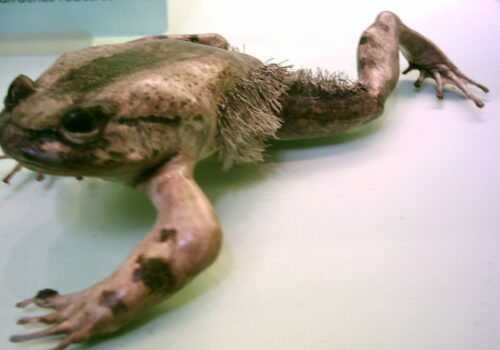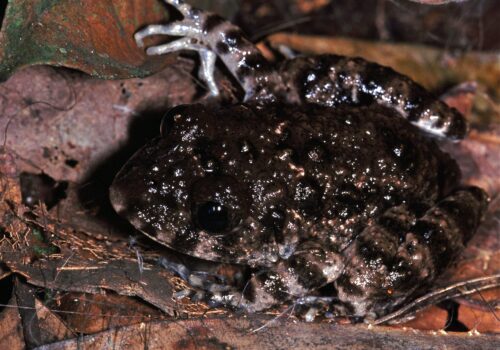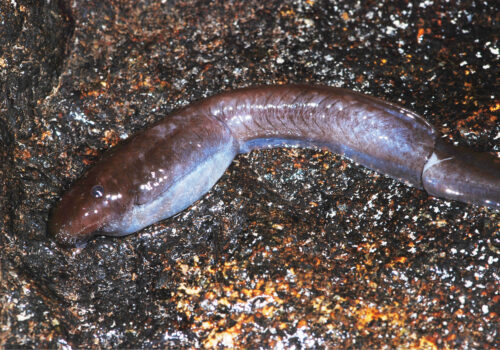- Introduction: A Cryptic Guardian of the African Forests
- Taxonomy and Classification
- Natural Habitat: A Symphony of Mist and Leaves
- Physical Characteristics: Mastering the Art of Camouflage
- Behavior and Life Cycle: Survival through Silence and Subtlety
- Ecological Role: Guardians of Biodiversity and Indicator Species
- Threats and Conservation Status: A Species on Thin Ice
- Cultural and Scientific Significance: Emblems of Mystery and Discovery
- Conclusion: Safeguarding a Forest Phantom's Future
Introduction: A Cryptic Guardian of the African Forests#
Beneath the dense foliage and misty canopy of Africa’s rich montane forests, a secretive creature dwells unseen and unnoticed by even the keenest observer. Known scientifically as Leptopelis anebos, this elusive amphibian belongs to an astonishingly diverse family of tree frogs that inhabit the continent’s lush terrain. Commonly referred to simply as “Anebòs’ Forest Tree Frog,” this remarkable amphibian remains largely undocumented and rarely encountered. Yet despite its cryptic lifestyle, the few glimpses we have into its existence paint an intriguing tale of adaptation, perseverance, and ecological significance.
At first glance, one might overlook Leptopelis anebos entirely. Its cloak-like camouflage, subtle vocalizations, and shy nature enables it to blend seamlessly into its vibrant, alive forest surroundings. However, delve deeper into its hidden world, and you’ll discover a vital ecological actor, intricately woven into the fabric of the African rainforest ecosystem. This article uncovers the life story of Leptopelis anebos, from its whispered presence among leafy branches to the delicate balance it maintains within its habitat.
Taxonomy and Classification#
Belonging to the Arthroleptidae family, a fascinating lineage of African frogs known for their diverse shapes, sizes, and behaviors, Leptopelis anebos finds its place comfortably in a genus renowned for its arboreal lifestyle. The genus Leptopelis currently comprises over 50 known species, spread throughout sub-Saharan Africa’s vibrant mosaic of forests, woodlands, and savannas. This particular species was described relatively recently, emerging onto scientific radars only through careful field exploration and dedicated amphibian surveys in its restricted habitat.
While closely related species like Leptopelis brevirostris and Leptopelis gramineus share similar niches, each has subtly distinct calls and morphologies, underlying the importance of detailed ecological studies. Indeed, understanding their precise taxonomic relationships provides conservationists and biologists with valuable knowledge, critical for informing protective strategies and ecological assessments of the region.
Natural Habitat: A Symphony of Mist and Leaves#
Leptopelis anebos is endemic to limited montane forest patches in Central Africa, primarily known from Cameroon’s pristine and biodiverse highlands. This species strongly prefers evergreen montane forests with thick foliage cover, high humidity, and moderate temperatures that seldom fluctuate drastically. Researchers often remark upon the challenging terrain this species inhabits—a maze of moss-covered trees, ferns cascading from branches, and steep mountain slopes shrouded in ever-present mist.
These conditions represent an ideal habitat for maintaining moisture and providing ample hiding places, a vital necessity for amphibians reliant on cutaneous (skin-based) respiration. Living primarily in lower canopies and amid thick shrubs, these frogs exemplify exceptional climbing abilities, using specialized adhesive pads on their feet to traverse challenging vertical surfaces effortlessly.
The Secret Ecosystem of the Forest Canopy#
Operating quietly above forest floors, canopy habitats offer essential resources for Leptopelis anebos. The warm dampness, protection from predators, and food abundance provided by a dense insect population create an evolutionary haven for this species. Apart from serving as feeding grounds, the leaf axils and water-filled tree hollows also provide crucial microhabitats for eggs and tadpoles, protecting them during vulnerable developmental stages.
The forest canopy, therefore, is much more than an abstract biological layer; it is the lifeblood of this species, shaping every facet of its life—from feeding behavior and reproductive strategy to daily survival mechanisms.
Physical Characteristics: Mastering the Art of Camouflage#
Unassuming coloration and subtle textures define the appearance of Leptopelis anebos. Measuring roughly between 3 to 5 centimeters, it is a small to medium-sized frog adorned in hues ranging from soft browns and ochres to subdued olive greens. The dorsal surface reveals delicate, often marbled patterns enabling near-perfect invisibility amid the leaves and branches.
Perhaps its most notable adaptation, however, lies in its remarkably large, expressive eyes, characteristic of the genus Leptopelis. Their golden or copper iris, ringed delicately with dark pigment, grants them exquisite night vision—a vital adaptation for their nocturnal lifestyles. Skin textures range from relatively smooth to slightly granular, aiding camouflage by mimicking the textures of bark, moss, or leaves.
This meticulous natural design not only protects them from predators but also optimizes their hunting efficiency, allowing them to approach prey undetected and strike swiftly and accurately.
Behavior and Life Cycle: Survival through Silence and Subtlety#
Nocturnal Hunters and Their Stealthy Pursuits#
During daylight hours, Leptopelis anebos typically remains motionless amidst foliage or under leaf litter, hidden from predators’ prying eyes. However, as darkness cloaks the forest, these tree frogs venture cautiously from hiding, navigating their arboreal terrain silently and precisely.
The species demonstrates impressive stealth and accuracy during hunting sessions, preying primarily upon insects such as crickets, moths, beetles, and spiders. Sensing prey with acute visual cues and possibly via vibrations felt through the leaves and branches, they execute swift, controlled leaps to capture insects with exceptional precision.
Intricate Courtship and Reproduction#
With the arrival of the rainy season, forest canopies resonate with a faint, melodious chorus—a beautiful yet discreet acoustic display that male Leptopelis anebos produce to attract females. Each male sings from a secure perch among dense foliage or hidden tree cavities, their soft repetitive calls carrying gently through humid air.
Females select mates based on call nuances and positioning, potentially indicating male fitness or territory quality. Once paired, eggs are laid in moist crevices, tree hollows, or leaf axils, providing protection from predators and stable microclimates required for embryonic development.
Tadpoles develop predominantly in these small watery nurseries, relying initially on yolk reserves before feeding upon algae and detritus found within micro-pools. This adaptive breeding strategy reduces vulnerability to aquatic predators common in traditional ponds and streams.
Ecological Role: Guardians of Biodiversity and Indicator Species#
Their insect-rich diets position Leptopelis anebos as valuable biological controls helping moderate insect populations within these delicate montane forest ecosystems. Additionally, as prey, these frogs provide necessary nutrients and energy transfers between trophic levels.
Perhaps less obviously, but equally important, Leptopelis anebos serves as ecological indicators. Amphibians are especially sensitive to environmental changes, and fluctuations in their populations often present timely warnings reflecting broader ecological disturbances. Monitoring their health and population stability helps scientists and conservationists understand forest resilience to climate change, habitat degradation, or pollution.
Threats and Conservation Status: A Species on Thin Ice#
Due to its extremely limited known range, specialized habitat requirements, and ongoing deforestation threats, Leptopelis anebos is presently classified as Data Deficient by the IUCN. Rampant habitat loss from logging, agriculture expansion, and urbanization severely threatens its long-term survival prospects.
Moreover, climate change brings unpredictable rainfall patterns and temperature shifts, further exacerbating these systematic stresses. Dedicated research, regular monitoring, and urgent habitat protection initiatives represent our best hope for preserving this mysterious species and its fragile forest home.
Cultural and Scientific Significance: Emblems of Mystery and Discovery#
While relatively unknown culturally due to its elusive nature, amphibians worldwide occupy cherished roles in local traditions, symbolizing fertility, rainfall, or natural health balancing mechanisms. Scientifically, new species like Leptopelis anebos represent frontiers of biodiversity, embodying undiscovered ecological adaptations and genetic knowledge essential to understanding and conserving Earth’s diminishing natural habitats.
Conclusion: Safeguarding a Forest Phantom’s Future#
Ultimately, preserving Leptopelis anebos means safeguarding entire ecosystems, symphonies of biodiversity echoing fascinating tales of adaptation, survival, and interconnectedness. By understanding and valuing this cryptic amphibian, we affirm commitments toward protecting our planet’s most vulnerable species. Let us strive together, raise awareness, support conservation efforts, and celebrate nature’s remarkable, quiet storytellers hidden deep within its forested heart.










